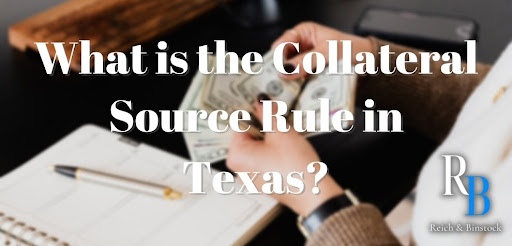You’re driving in your car, and all of a sudden, another driver hits you. The financial costs and the emotional and physical injuries after a car wreck can be overwhelming. It is your right to seek compensation for damages when the other driver is responsible for the crash. Luckily, there is something called the collateral source rule that protects the amount of money you can get after a wreck. So, what is the collateral source rule?
You have health insurance, so your insurer covers the cost of your medical bills, and when you file a personal injury claim, the other driver argues they shouldn’t have to pay as a result. This is where the collateral source rule helps out. The collateral source rule prohibits your damages from being lessened if you benefit from collateral source payments or assistance, such as insurance and disability benefits.
As a result, this type of argument is unsuccessful in Texas. If you are involved in a vehicle collision caused by another driver, please call the law offices of Reich & Binstock right away. Our skilled Houston personal injury attorneys discuss your case with you and whether the collateral source rule applies in your circumstances. Call 713-622-7271 to schedule your free and confidential consultation. Our attorneys also handle VA disability claims for veterans whose benefits have been wrongfully denied or reduced.
What is the Collateral Source Rule?
The collateral source rule is two different but related common law rules in Texas. One is a rule of evidence, and the other is a rule of damages.
A collateral source rule law exists in some areas, preventing a plaintiff’s monetary damages from being reduced. This applies to costs covered by a third party, such as health or vehicle insurance payments or workers’ compensation benefits.
Therefore, the amount paid by other sources cannot be subtracted from the damages awarded to a plaintiff.
Evidence admission in court during a personal injury trial is the second part of the collateral source rule. It keeps a defendant in a personal injury case from introducing evidence that collateral or third-party source paid any amount of the plaintiff’s damages. Jury members can only look at payments from the at-fault individual. This even includes payments from the plaintiff’s health insurance coverage.
Even though compensation from a collateral source is not allowed during a trial, the defendant can look into the amount of collateral compensation and its origin.
Examples of collateral sources include life, medical, property, vehicle insurance, social security disability benefits, workers compensation benefits, and any gratuitous services provided to the plaintiff. A gratuitous service can be anything from a donated vehicle to someone repairing damaged property free of charge.
How Does the Collateral Source Rule Affect Personal Injury Cases?
Even though you have insurance coverage, you still retain the right to file a personal injury lawsuit against the at-fault party. This is a fundamental right, and the collateral source rule exists to protect it.
This legal doctrine prevents the defendant in your lawsuit from benefiting from your insurance coverage as well. In other words, the fact that your insurance or another third party compensated you for your injuries doesn’t let the person who injured you off the hook.
Even though personal injury lawsuits are about getting compensation for your damages, they’re also a way to hold a person accountable for negligence.
You deserve to be made whole and recover compensation if you suffer from an injury caused by another person’s negligence. Your damages include current expenses such as lost wages and medical bills and future costs including disability, reduced earning capacity, and emotional distress. The at-fault party’s responsibility is to compensate you for your injuries fully.
Types of Damages
In Texas, damages in a personal injury case are usually a combination of two types of damages. These damages are economic and non-economic.
- Economic damages are the measurable costs sustained by the plaintiff, now or in the future. Lost wages, medical costs, and property damage are common monetary damages.
- Non-economic damages – These types of injuries are less concrete. These include pain and suffering and loss of consortium.
More rarely, a third type of damages is awarded. These are punitive damages. A punitive damages award punishes the defendant for negligence. They also help prevent future harmful actions. Under Texas Civil Practices and Remedies Code § 41.003, these damages are available after the plaintiff presents unmistakable evidence that malice, fraud, or gross neglect caused the harm.
What Is the Rationale for the Collateral Source Rule?
Some critics of the collateral source rule argue it’s a way for an injured person to collect a double payment. Meanwhile, those in favor believe the rule is necessary. They think it is a way to ensure members of society abide by a standard of reasonable care. As such, the cost of negligent or reckless behavior is the responsibility of the defendant or person bearing fault.
Example of the Collateral Source Rule
A driver causes a car wreck due to negligence. The other driver’s medical bills for their injuries total $50,000. The injured driver’s insurance company pays $50,000 to cover health care expenses, and their parents give them a car to replace the damaged vehicle.
The victim can pursue damages from the at-fault party for the total amount of their medical expenses, plus the property damage to their vehicle. Evidence of the plaintiff’s insurance payment or their parent’s gift is not allowed.
Case Study
Per the collateral source rule, if your case goes to trial, you can ask the jury to award damages for hospital bills based on the amount the hospital billed, rather than the discounted amount your insurance provider paid.
Look at it this way. Imagine an injured person has Medicaid. Their medical bills total $250,000, but Medicaid’s pay rate is $75,000. If the case goes to trial in Texas, the collateral source rule allows them to present a jury with the total medical expenses billed by providers. In this case, $250,000 instead of the $75,000 accepted as full payment for these healthcare services.
Reasonable Value
The above example shows quite a difference between paying $75,000 for medical bills and $250,000. If you’re in a state where the collateral source rule isn’t applicable, you’re limited to presenting evidence of the $75,000 in medical expenses paid by your insurer.
In every jurisdiction, the law allows a plaintiff to address such situations by recovering the “reasonable value” of the medical services they received. However, the subject of reasonable medical expenses is not clear, and litigation and legislation surrounding it continue.
In Texas, there are instances where the collateral source rule may not apply. One example when it may not apply is for damage restrictions. These are also called “caps.” These limit the amount of money recoverable for a claim.
Caps on Damages
No caps exist for economic damages in personal injury cases in Texas. However, non-economic and punitive damages have certain limitations. For example, the upper limit for a medical malpractice award against health care providers or doctors is $250,000. It is $500,000 when the case involves multiple health care providers.
For punitive damages, two times the economic damage amount, or $200,000, plus up to $750,000 for non-economic damages, is the cap. In addition, a claim against a government agency is limited to $250,000 for a single plaintiff and $500,000 for multiple plaintiffs.
Exceptions to the Collateral Source Rule
Exceptions to the collateral source rule do exist. The most significant exception is an insurance company’s subrogation rights. When an insurance carrier pays a victim’s medical bills, subrogation lets them sue either the defendant or their insurance provider for those funds. The insurer can also recoup monies from a victim once they receive an award.
Another exception is possible when victims keep working after being injured or don’t seek medical treatment for injuries.
In Brown v. American Transfer & Storage Co. (Tex. 1980), the Supreme Court of Texas explained, “The theory behind the collateral source rule is that a wrongdoer should not have the benefit of insurance independently procured by the injured party, and to which the wrongdoer was not privy.”
Financial Hardship Exception
If a plaintiff doesn’t give accurate testimony about the amount of collateral benefits they’ve received, this is another exception. If this occurs, such evidence may be admissible for impeachment purposes. The plaintiff must be accurate about any financial hardship stemming from the injury to avoid this.
Contact a Houston Personal Injury Lawyer Today
It is best if you have a law firm on your side with attorneys familiar with the collateral source rule. It pays off to your benefit when it’s time to negotiate a settlement on your case.
Reich & Binstock’s experienced Houston personal injury lawyers feel pride in helping people in Houston and the surrounding areas. We are ready to review your Houston car accident or Houston personal injury case and establish an attorney-client relationship with you. The initial consultation is free, and our firm is paid on a contingency basis. That means we don’t get paid unless we secure damages for your case! Please call our personal injury attorneys Houston at 713-622-7271 or complete our online form. Our firm handles a range of personal injury practice areas, including the following:













